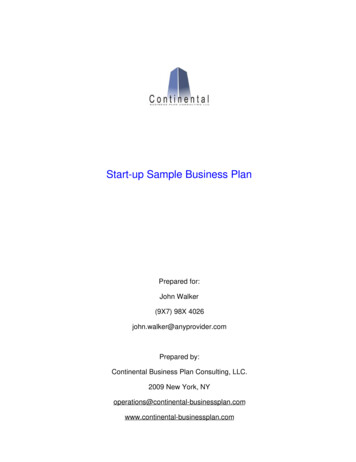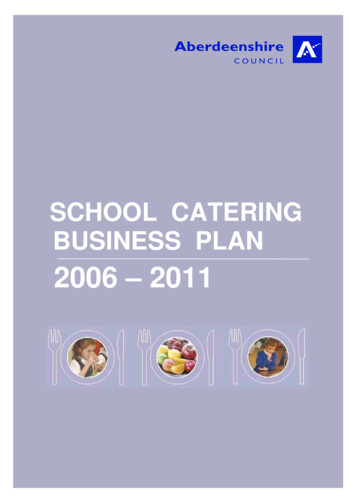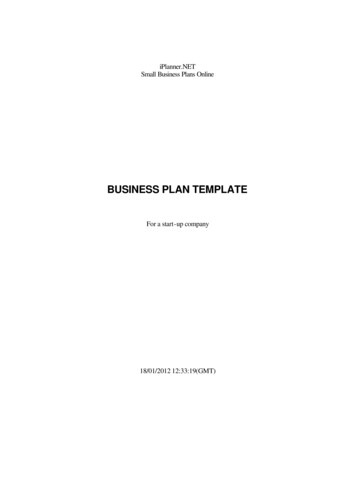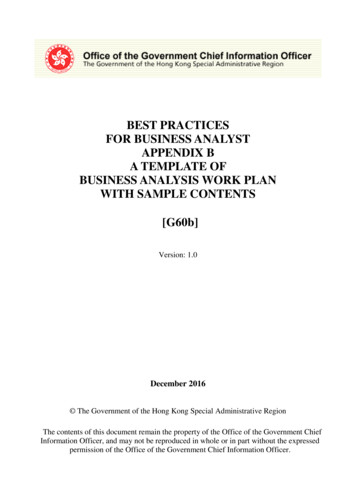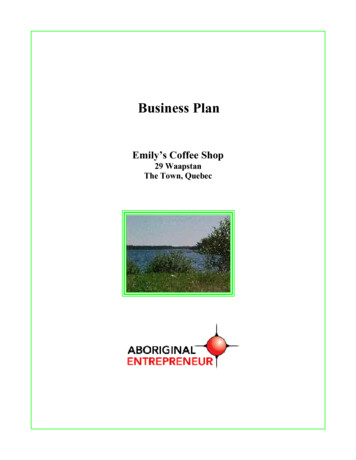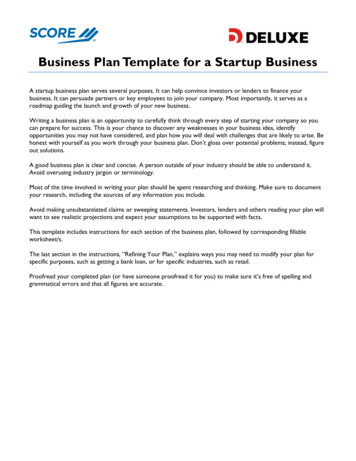
Transcription
Business Plan Template for a Startup BusinessA startup business plan serves several purposes. It can help convince investors or lenders to finance yourbusiness. It can persuade partners or key employees to join your company. Most importantly, it serves as aroadmap guiding the launch and growth of your new business.Writing a business plan is an opportunity to carefully think through every step of starting your company so youcan prepare for success. This is your chance to discover any weaknesses in your business idea, identifyopportunities you may not have considered, and plan how you will deal with challenges that are likely to arise. Behonest with yourself as you work through your business plan. Don’t gloss over potential problems; instead, figureout solutions.A good business plan is clear and concise. A person outside of your industry should be able to understand it.Avoid overusing industry jargon or terminology.Most of the time involved in writing your plan should be spent researching and thinking. Make sure to documentyour research, including the sources of any information you include.Avoid making unsubstantiated claims or sweeping statements. Investors, lenders and others reading your plan willwant to see realistic projections and expect your assumptions to be supported with facts.This template includes instructions for each section of the business plan, followed by corresponding fillableworksheet/s.The last section in the instructions, “Refining Your Plan,” explains ways you may need to modify your plan forspecific purposes, such as getting a bank loan, or for specific industries, such as retail.Proofread your completed plan (or have someone proofread it for you) to make sure it’s free of spelling andgrammatical errors and that all figures are accurate.
Business Plan[Insert Date]Company nameStreet address 1Street address 2City, state, ZIPBusiness phoneWebsite URLEmail address2
Confidentiality AgreementThe undersigned reader acknowledges that any information provided byin this business plan, other than information that is in the publicdomain, is confidential in nature, and that any disclosure or use of same by the reader may cause seriousharm or damage to . Therefore, the undersigned agrees not to discloseit without express written permission from .Upon request, the undersigned reader will immediately return this document to.SignatureName (typed or printed)DateThis is a business plan. It does not imply an offering of securities.3
Table of ContentsConfidentiality Agreement .3I. Instructions: Executive Summary.5Executive Summary .6II. Instructions: Company Description .7Company Description Worksheet .8III. Instructions: Products & Services .9Product & Service Description Worksheet . 10IV. Instructions: Marketing Plan .11SWOT Analysis Worksheet . 12Competitor Data Collection Plan . 14Competitive Analysis Worksheet . 15Marketing Expenses Strategy Chart . 17Pricing Strategy Worksheet . 19Distribution Channel Assessment Worksheet . 21V. Instructions: Operational Plan .23VI. Instructions: Management & Organization .25Management Worksheet. 26Organization Chart . 27VII. Instructions: Startup Expenses & Capitalization .28VIII. Instructions: Financial Plan .29IX. Instructions: Appendices .31X. Instructions: Refining the Plan .32Now That You’re (Almost) Finished . . . .344
I. Instructions: Executive SummaryThe Executive Summary is the most important part of your business plan. Often, it’s the only part that aprospective investor or lender reads before deciding whether or not to read the rest of your plan. It shouldconvey your enthusiasm for your business idea and get readers excited about it, too.Write your Executive Summary LAST, after you have completed the rest of the business plan. That way, you’llhave thought through all the elements of your startup and be prepared to summarize them.The Executive Summary should briefly explain each of the below.1. An overview of your business idea (one or two sentences).2. A description of your product and/or service. What problems are you solving for yourtarget customers?3. Your goals for the business. Where do you expect the business to be in one year, three years,five years?4. Your proposed target market. Who are your ideal customers?5. Your competition and what differentiates your business. Who are you up against, andwhat unique selling proposition will help you succeed?6. Your management team and their prior experience. What do they bring to the table thatwill give your business a competitive edge?7. Financial outlook for the business. If you’re using the business plan for financing purposes,explain exactly how much money you want, how you will use it, and how that will make yourbusiness more profitable.Limit your Executive Summary to one or two pages in total.After reading the Executive Summary, readers should have a basic understanding of your business, should beexcited about its potential, and should be interested enough to read further.After you’ve completed your business plan, come back to this section to write your executive summary onthe next page.5
Executive Summary(Write after you’ve completed the rest of the business plan.)6
II. Instructions: Company DescriptionThis section explains the basic elements of your business. Include each of the below:1. Company mission statementA mission statement is a brief explanation of your company’s reason for being. It can be as short as amarketing tagline (“MoreDough is an app that helps consumers manage their personal finances in a fun,convenient way”) or more involved: (“Doggie Tales is a dog daycare and grooming salon specializing inconvenient services for urban pet lovers. Our mission is to provide service, safety and a family atmosphere, enablingbusy dog owners to spend less time taking care of their dog’s basic needs and more time having fun with theirpet.”) In general, it’s best to keep your mission statement to one or two sentences.2. Company philosophy and visiona. What values does your business live by? Honesty, integrity, fun, innovation and community are valuesthat might be important to your business philosophy.b. Vision refers to the long-term outlook for your business. What do you ultimately want it tobecome? For instance, your vision for your doggie day-care center might be to become a nationalchain, franchise or to sell to a larger company.3. Company goalsSpecify your long- and short-term goals as well as any milestones or benchmarks you will use to measureyour progress. For instance, if one of your goals is to open a second location, milestones might includereaching a specific sales volume or signing contracts with a certain number of clients in the new market.4. Target marketYou will cover this in-depth in the Marketing Plan section. Here, briefly explain who your targetcustomers are.5. IndustryDescribe your industry and what makes your business competitive: Is the industry growing, mature orstable? What is the industry outlook long-term and short-term? How will your business take advantage ofprojected industry changes and trends? What might happen to your competitors and how will yourbusiness successfully compete?6. Legal structurea. Is your business a sole proprietorship, LLC, partnership or corporation? Why did you choose thisparticular form of business?b. If there is more than one owner, explain how ownership is divided. If you have investors, explainthe percentage of shares they own. This information is important to investors and lenders.After reading the Company Description, the reader should have a basic understanding of your business’s missionand vision, goals, target market, competitive landscape and legal structure.Use the Company Description worksheet on the next page to help you complete this section.7
Company Description WorksheetBusiness NameCompany MissionStatementCompanyPhilosophy/ValuesCompany Vision1.Goals & Milestones2.3.Target Market1.Industry/Competitors2.3.Legal Structure/Ownership8
III. Instructions: Products & ServicesThis section expands on the basic information about your products and services included in the ExecutiveSummary and Company Description. Here are some items to consider:1. Your company’s products and/or services: What do you sell, and how is it manufactured orprovided? Include details of relationships with suppliers, manufacturers and/or partners that areessential to delivering the product or service to customers.2. The problem the product or service solves: Every business needs to solve a problem that itscustomers face. Explain what the problem is and how your product or service solves it. What are itsbenefits, features and unique selling proposition? Yours won’t be the only solution (every business hascompetitors), but you need to explain why your solution is better than the others, targets a customerbase your competitors are ignoring, or has some other characteristic that gives it a competitive edge.3. Any proprietary features that give you a competitive advantage: Do you have a patent onyour product or a patent pending? Do you have exclusive agreements with suppliers or vendors tosell a product or service that none of your competitors sell? Do you have the license for a product,technology or service that’s in high demand and/or short supply?4. How you will price your product or service: Describe the pricing, fee, subscription or leasingstructure of your product or service. How does your product or service fit into the competitivelandscape in terms of pricing—are you on the low end, mid-range or high end? How will that pricingstrategy help you attract customers? What is your projected profit margin?Include any product or service details, such as technical specifications, drawings, photos, patent documents andother support information, in the Appendices.After reading the Products & Services section, the reader should have a clear understanding of what your businessdoes, what problem it solves for customers, and the unique selling proposition that makes it competitive.Use the Product and Service Description Worksheet on the next page to help you complete this section.9
Product & Service Description WorksheetBusinessNameProduct/Service IdeaSpecialBenefitsUniqueFeaturesLimits andLiabilitiesProductionand sProduct/ServiceDescription10
IV. Instructions: Marketing PlanThis section provides details on your industry, the competitive landscape, your target market and how you willmarket your business to those customers.1. Market researchThere are two kinds of research: primary and secondary. Primary market research is information you gatheryourself. This could include going online or driving around town to identify competitors; interviewing or surveyingpeople who fit the profile of your target customers; or doing traffic counts at a retail loc
Business Plan Template for a Startup Business A startup business plan serves several purposes. It can help convince investors or lenders to finance your business. It can persuade partners or key employees to join your company. Most importantly, it serves as a roadmap guiding the launch and growth of your new business. Writing a business plan is an opportunity to carefully think through every .




